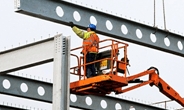Analysis

January 15, 2019
AGC: Construction Costs Down in December, But Up for the Year
Written by Sandy Williams
Construction costs declined in December after a year of price spikes, but remained higher than a year ago, said the chief economist for the Associated General Contractors of America.
“Steep declines in fuel prices in December offset mixed costs for other construction inputs, but most materials and services posted higher year-over-year increases than in 2017,” said AGC’s Ken Simonson in an analysis of government data. “The price index for new building construction outpaced the input cost index at the end of the year, but many contractors were probably caught by unexpected cost increases in 2018.”
The producer price index for goods and services used in construction decreased 0.8 percent in December, but was 3.8 percent higher than in December 2017. Although energy costs declined 11.5 percent for the month and 3.9 percent for the year, prices for other goods used in construction climbed 0.1 percent for the month and 4.8 percent for the year, commented Simonson. The component of the index tracking services purchased by contractors also increased, rising 0.4 percent in December and 4.2 percent for the year. The increases for goods and services followed 2017 gains of 3.3 percent and 3.7 percent, respectively.
Contractor charges for construction of new nonresidential buildings were unchanged for the month, but 5.3 percent higher than a year ago.
Association officials said higher construction prices will increase the cost of many public infrastructure projects and could undermine the financial viability of new private-sector development projects. They urged Washington officials to resolve trade disputes that have led to new and threatened tariffs on a host of construction materials. They also called for comprehensive immigration reform and new federal investments in career and technical education to prepare and recruit more people into the construction industry.
“Public officials may be forced to scale back planned infrastructure projects to cope with higher costs, while many privately financed projects may no longer pencil out if construction costs continue to increase,” said Stephen E. Sandherr, the association’s chief executive officer. “Resolving costly trade disputes and addressing labor shortages will help relieve much of the inflationary pressure on construction costs.”







